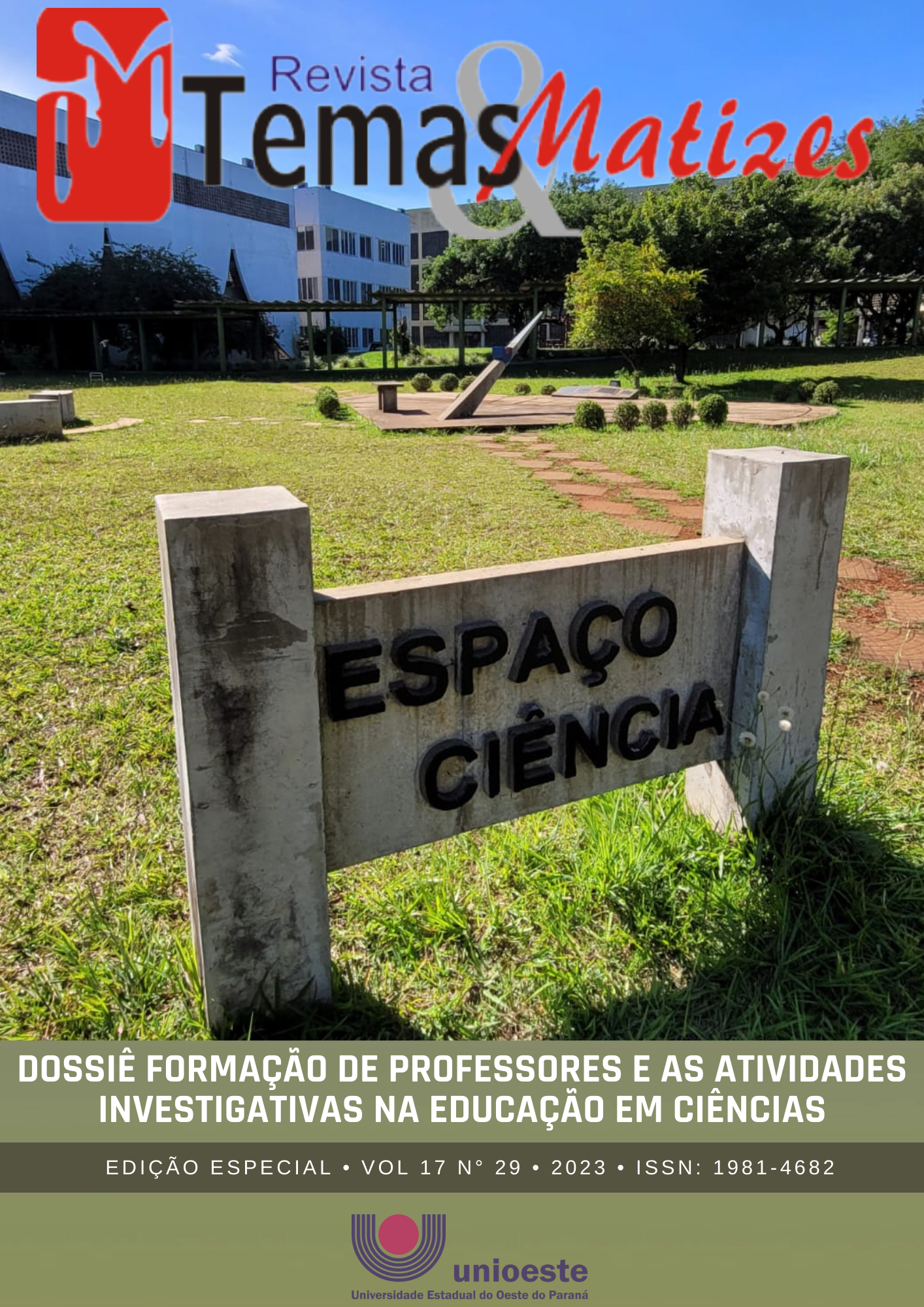Chapeuzinho Vermelho sob o olhar do Ensino de Ciências: contribuições para a alfabetização científica
DOI:
https://doi.org/10.48075/rtm.v17i29.32022Keywords:
Scientific literacy, Early Years, Children's literatureAbstract
Scientific literacy in the early years helps students to better understand the world, and can be inserted into the educational environment through children's literature. The objective of this research was to identify indicators of Scientific Literacy in the speeches of children in conversation circles related to the telling of the story of Little Red Riding Hood and to investigate the stereotype of the wolf character. The study has a qualitative approach focusing on exploratory research, case study, and classification of Scientific Literacy indicators. The results revealed that children present conceptions related to the wolf character that are strongly influenced by the story of Little Red Riding Hood. Furthermore, they make a distinction between the fictional world and the real one, although the majority do not separate the wolf animal from the character, characterizing them all as dangerous. As indicators of scientific literacy, it is possible to notice that they mix the real and imaginary worlds in their speeches and stereotypes interfere in their explanatory and justifying arguments about comparing the character wolf with the animal wolf. In this way, the teacher can use this discussion in the classroom to promote awareness and appreciation of fauna animals, providing scientific literacy.
References
AMARAL, L. A. Sobre crocodilos e avestruzes: falando de diferenças físicas, preconceitos e sua superação. In: AQUINO, Julio Groppa (Org.). Diferenças e preconceito na escola: alternativas teóricas e práticas. São Paulo: Summum, 1998. p. 12-13-15-17-18 -26.
ANTOGLA, D. C. A articulação entre a literatura infantil e o ensino de ciências nos anos iniciais do ensino fundamental. 2014, 151 p. Dissertação (Pós-Graduação Stricto Sensu em Educação) -Universidade Comunitária da Região de Chapecó (UNOCHAPECÓ), Chapecó, SC, 2014.
BETTELHEIM. B. A psicanálise dos contos de fadas. 16a Edição. [s.l]: Ed. Paz e terra, 2002. 335p. Disponível em: < http://fernandomaues.com/noigandres/textos/ensino/a_psicanalise_dos_contos_de_fadas.pdf> Acesso em 19 de ago. 2022.
BOGDAN, R.; BIKLEN, S. Investigação qualitativa em educação: uma introdução à teoria e aos métodos. Porto: Porto Editora, 2010.
BREUNIG, E. T. Clássicos da literatura infantil sob o olhar do ensino. De ciências: uma proposta para os anos iniciais. 2020. Dissertação (Mestrado em Educação em Ciências: Química da Vida e Saúde) - Universidade Federal de Santa Maria, Santa Maria, RS, 2020.
CHASSOT, A. Alfabetização científica: uma possibilidade para a inclusão social. Revista Brasileira de Educação. Rio de janeiro, Nº 22, p. 89-100, Jan./Abr. 2003. Disponível em: <https://www.scielo.br/scielo.php?script=sci_arttext&pid=S1413-24782003000100009> Acesso em: 20 de fev. 2023.
FELIPE, J. O lobo mau que é bom: a re-versão do mito nas histórias infantis. 2007. 92 p. Dissertação (Mestrado em Ciências da Linguagem) - Universidade do Sul de Santa Catarina, Palhoça, 2007.
GIL, A. C. Como elaborar projetos de pesquisa. São Paulo: Atlas, 2002.
MACHADO, G.V; FONSECA, C.C; NEVES, M.T. Topografia do cone medular no lobo-guará (Chrysocyon brachyurus llliger, 1815). R. bras. Ci. Vet., v. 9, n. 2, p. 107-109, maio/ago. 2002. Disponível em: Acesso em: 04 de jan. 2022.
MELGAÇO, I.C.P. Ética animal no ensino de ciências e biologia: uma análise de livros didáticos da educação básica. 2015, 132 f. Tese (Doutorado em Bioética, Ética Aplicada e Saúde Coletiva) - Universidade Federal Fluminense, Niterói, RJ, 2015.
MONDEK, S.A; ROCHA, Z.F; LIMA, J. P. Serões de dona benta monteiro lobato e o ensino de ciências. REnCiMa, v. 10, n.1, p. 184-193, 2019. Disponível em: Acesso em 29 de dez. 2022.
OLIVEIRA, H.T; FIGUEIREDO, A.N; TULLIO, A. Educação ambiental para a conservação da biodiversidade: animais de topo de cadeia [livro eletrônico] - São Carlos, SP: Diagrama Editorial, 2016.
RICKLEFS, R.E. A Economia da Natureza. Rio de Janeiro: Guanabara Koogan, 2003.
SASSERON, L.H; CARVALHO, A.M.P. Almejando a alfabetização científica no ensino fundamental: a proposição e a procura de indicadores do processo. Investigações em Ensino de Ciências – V13(3), pp.333-352, 2008.
SASSERON, L.H; CARVALHO, A.M.P. Alfabetização científica: uma revisão bibliográfica. Investigações em Ensino de Ciências – V16(1), pp. 59-77, 2011.
SILVA, E.V. K. Quem tem medo do lobo mau? A representação do lobo em contos e recontos. LING. – Est. e Pesq., Catalão-GO, vol. 19, n. 1, p. 97-113, jan./jun. 2015.
VARISE, E.M, et al. Revisão dos conceitos sobre a evolução bípede e aplicação na Fisioterapia. Revista Neurociências. 2009, 17(3), 246-254. Disponível em: <https://periodicos.unifesp.br/index.php/neurociencias/article/view/8549/6083> Acesso em: 07 de fev.2020.
ZAMBON, S.A. Reflexões sobre a construção estereotipada de heróis e heroínas das histórias infantis. Monografia (especialização em Educação Infantil e a Escola de Nove Pesquisas e Gestão do Cotidiano Escolar) -Universidade Federal de São Carlos, São Carlos, 2009.
Downloads
Published
How to Cite
Issue
Section
License

This work is licensed under a Creative Commons Attribution-NonCommercial-ShareAlike 4.0 International License.
Aviso de Direito Autoral Creative Commons
Política para Periódicos de Acesso Livre
Autores que publicam nesta revista concordam com os seguintes termos:
1. Autores mantém os direitos autorais e concedem à revista o direito de primeira publicação, com o trabalho simultaneamente licenciado sob a Licença Creative Commons Attribution que permite o compartilhamento do trabalho com reconhecimento da autoria e publicação inicial nesta revista.2. Autores têm autorização para assumir contratos adicionais separadamente, para distribuição não-exclusiva da versão do trabalho publicada nesta revista (ex.: publicar em repositório institucional ou como capítulo de livro), com reconhecimento de autoria e publicação inicial nesta revista.
3. Autores têm permissão e são estimulados a publicar e distribuir seu trabalho online (ex.: em repositórios institucionais ou na sua página pessoal) a qualquer ponto antes ou durante o processo editorial, já que isso pode gerar alterações produtivas, bem como aumentar o impacto e a citação do trabalho publicado (Veja O Efeito do Acesso Livre).
Licença Creative Commons
Esta obra está licenciada com uma Licença Creative Commons Atribuição-NãoComercial-CompartilhaIgual 4.0 Internacional, o que permite compartilhar, copiar, distribuir, exibir, reproduzir, a totalidade ou partes desde que não tenha objetivo comercial e sejam citados os autores e a fonte.


